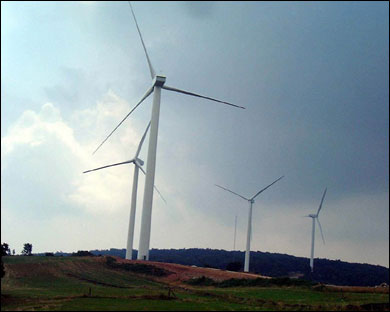|
|
||||
|
|
Carnegie Mellon Gives Renewable Energy the "Green" Light
By 2008, 20 percent of the university's electricity will come from renewable or "green" sources, like wind energy, small hydropower and landfill gas resources.
The lights in your office don't shine any brighter, and the computer on your desk doesn't run any faster. But earlier this year Carnegie Mellon University's power supply got a little "greener" when the university extended — and expanded — its commitment to using renewable energy sources.
Long dedicated to technologies and practices that protect and enhance the environment, Carnegie Mellon took a major step forward in 2001 when it made a commitment to purchase five percent of its total electricity from wind power generated in western Pennsylvania. That commitment, at the time the largest single retail purchase of wind-generated electricity in the U.S., has steadily increased each year. In 2005, nearly 11 percent of the university's electrical energy came from renewable or "green" sources.
This past spring, Carnegie Mellon once again established itself as a leader in renewable energy initiatives by increasing the "green" energy it purchases to 15 percent of the university's total energy consumption. The university annually uses about 100 million kilowatt-hours of electricity each year, so about 15 million of those kilowatt hours will now come from renewable sources — not fossil fuels. That number will grow to 17.5 percent in 2007 and 20 percent in 2008.
Extending the university's renewable energy contract reaffirms Carnegie Mellon's dedication to sustainability and protecting the global environment.
"Carnegie Mellon has long been a leader in higher education in the extent of our commitment to creating a more sustainable environment, and we show this not just through our research and education programs, but also through our actions. By extending — actually, increasing — our contract for renewable electricity, we demonstrate that commitment and further emphasize the importance of 'green' technology in our daily lives," said Carnegie Mellon President Jared L. Cohon.
"One hundred percent of the energy going to LEED-certified buildings is from this pool of renewable energy resources. That's not a requirement. We choose to do that," Hochberg said. "All the power for New House, for example, or the Gates Center for Computer Science (when it's finished) will come from renewable resources. Other examples are Henderson House and the Posner Center, as well as some smaller renovation projects."
When Carnegie Mellon originally penned the 2001 agreement, 100 percent of renewable energy the university received was powered by wind. Today, the university receives electricity generated by three renewable sources: wind, small hydropower and landfill gas resources (captured methane gas given off by trash and converted into power). By using these sources instead of traditional fossil fuels, Carnegie Mellon helps reduce air pollution, which in turn improves air quality and human health.
In fact, Carnegie Mellon's investment in green energy will help reduce acid rain by decreasing the amount of sulfur dioxide and nitrous oxide emitted into the environment. It will also eliminate the production of nearly 21,000 tons of carbon dioxide — the primary contributor to global warming. According to the Environmental Protection Agency, this reduction in carbon dioxide emissions is equivalent to planting 2,700 acres of trees and taking 3,700 cars off the road.
Though green energy costs more than other fossil-fuel alternatives, its annual price tag is only slightly more than one percent of the university's total utility budget. Hochberg says other simple changes in behavior on campus would more than make up for it. For example, updating heating, cooling and lighting technology — combined with encouraging people to do simple things like turning off their lights and computer monitors when they leave their offices — could significantly reduce the university's energy consumption and save an equally substantial amount of money as well.
But while the university's spending slightly more, Hochberg says it is reaping an even greater benefit by investing in the environment.
Think about that the next time you turn on your computer.
Susie Cribbs |
||
|
Carnegie Mellon Home |
||||

 According to Bradley Hochberg, Carnegie Mellon's energy manager, the university's decision to increase the current amount of "green" energy it purchases stems from its policy that all new campus construction strive to receive Leadership in Energy and Environmental Design (LEED) certification from the U.S. Green Building Council.
According to Bradley Hochberg, Carnegie Mellon's energy manager, the university's decision to increase the current amount of "green" energy it purchases stems from its policy that all new campus construction strive to receive Leadership in Energy and Environmental Design (LEED) certification from the U.S. Green Building Council.